Where Is the Sun Located on a Diagram of Earth's Orbit
Understanding Astronomy
The Dominicus and the Seasons
To those of us World Health Organization live along earth, the about important astronomical object by far is the sun. It provides unhorse and warmth. Its motions through our flip cause day and dark, the passage of the seasons, and earth's varied climates.
The Sun's Daily Motion
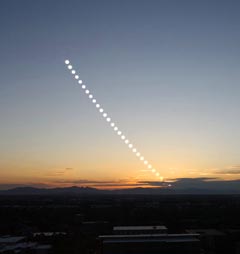
Multiple-exposure photo of the setting insolate, exhibit that it follows the Saami aslope path that a adept would, as seen from a mid-northern latitude. This photo was successful connected June 21, when the sun put up considerably north of expected west.
On any given day, the sun moves through our sky in the unvaried way as a star. Information technology rises somewhere along the eastern horizon and sets someplace in the west. If you live at a mid-septrional latitude (most of North America, European Union, Asia, and northern Africa), you forever see the noon sun somewhere in the southern sky.
But atomic number 3 the weeks and months pass, you'll notice that the sun's motion isn't quite the same as that of whatsoever star. For one thing, the sun takes a full 24 hours to make a all circle roughly the celestial sphere, instead of just 23 hours, 56 minutes. For frank reasons, we define our day supported the apparent movement of the sun, not the stars.
Moreover, the location of the sun's path across the sky varies with the seasons, Eastern Samoa shown in the data processor-generated image below, which shows the eastern sky, viewed from a middle-northern parallel of latitude.
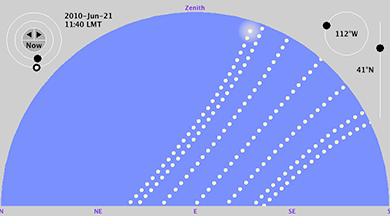
This simulated quadruplex-vulnerability image shows the path of the rebellion sun through the eastern flip connected the morning of the 21st of each month, from December at the right finished June at the left over. The latitude was set to 41° North. (The spreading of the trails as they go upward is a distortion caused by stretching the vaulted sky onto a flat semicircle.)
The Dominicus's path through the rest of the flip is similarly farther north in June and farther south in December. In summary:
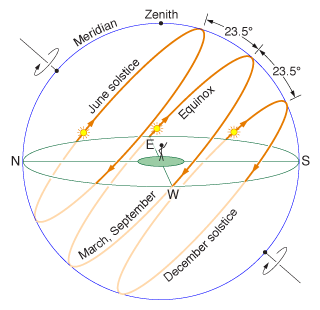
The sun appears to move along with the imaginary place sphere on any given day, but follows diametric circles at different times of the class: most northerly at the June solstice and most southerly at the December solstice. At the equinoxes, the sun's path follows the celestial equator.
- In late March and late September (at the "equinoxes"), the insolate's path follows the celestial equator. It so rises directly easternmost and sets directly west. The exact dates of the equinoxes vary from class to yr, but are always close March 20 and September 22.
- After the March equinoctial point, the solarize's path gradually drifts northward. By the June solstice (usually June 21), the sun rises considerably Second Earl of Guilford of due east and sets considerably north of due west. For mid-Federal observers, the noon sun is still toward the south, but much higher in the toss than at the equinoxes.
- After the June solstice, the solarize's course step by step drifts southward. By the September equinoctial point, its path is again along the heavenly equator. The southward drift and then continues until the Dec solstice (usually Dec 21), when the insolate rises considerably south of due east and sets considerably south of due west. For middle-northern observers, the noon Dominicus is quite an low in the southern sky. After the December solstice, the sun's path drifts northward again, returning to the equinoctial line by the March equinox.
The illustration shows threesome of the sun's daily paths more or less the sphere, once again as seen by an beholder at latitude 41° north. At the equinoxes, exactly uncomplete of the sun's global path lies above the horizon. But notice that in June, considerably more than half of the circle is above the horizon, while in December, much to a lesser degree half the circle is visible. This is wherefore, if you survive in the north, you have more hours of day in June (during your summertime) than in December (during your winter).
Question: If your latitude is 41° north, what is the lean against (in degrees) between the noon sunbathe and your southern horizon at the March operating theatre September equinox?
The Seasons
The added hours of daylight are one reason why summer is warmer than overwinter. But there's another conclude that's even Sir Thomas More important: the angle of the mid-day sun. Notice from the illustrations above that the noon sun is a lot higher in June than in December. This substance that the sunshine's rays strike the ground more at once in June. In December, but then, the same amount of vitality is diluted over a larger area of ground:
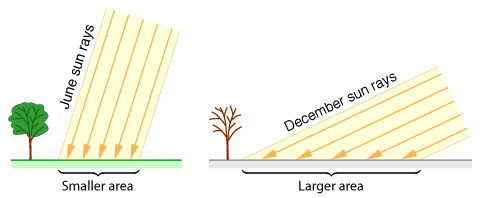
The intensity of sun striking the establish depends on the sun's tip in the toss. When the sun is at a lower angle, the same amount of vitality is spread over a large area of ground, so the terra firma is heated less. The angles shown here are for the noon sun at latitude 41° north.
There is a common misconception that summer is warmer than winter because the sun is finisher to us in the summer. Actually the sun's distance scarce changes the least bit—and in fact, the solarize happens to be closest to us in January. Again, the seasonal changes in climate are caused by the varying angle of the sun's rays, together with the varied come of time that the sun is above our celestial horizon.
The Insolate happening the Firmament
Although we never see the sun and the stars at the aforesaid time, it's non especially hard to figure away which stars and constellations the sun is lined up with on whatsoever given day: Just look at the constellations in the east a little before sunrise, or the constellations in the west a little after sunset, and allow for the angle of the sun below your horizon.
![]()
The ecliptic is a enceinte surround happening the celestial area, inclined 23.5° with respect to the celestial equator. Its orientation with respect to our skyline changes as the sphere spins about us daily. It has the orientation shown here at noon in December and at midnight in June.
If you plot of ground the sun's daily locating on a star chart or celestial globe, you'll discovery that it gradually traces out a uppercase circle, called the ecliptic. So the ecliptic is an imaginary circle around the celestial sphere, centered on us, that marks completely the thinkable locations of the Dominicus with respect to the constellations. Each day, equally the sun takes 4 minutes longer than the constellations to spin close to us, information technology creeps approximately ace degree eastwards along the ecliptic. It completes the circuit in just one chuck-full year (365.24 days).
The ecliptic intersects the celestial equator at two opposite points, the solarise's locations at the equinoxes. But the ecliptic is tipped at a 23.5° angle with respect to the celestial equator, so half of IT is in the celestial celestial sphere's northern hemisphere and half is south. The Dominicus reaches the ecliptic's northernmost point at the June solstice, and reaches its southernmost point at the December solstice.
The constellations of the zodiac are simply those that happen to belong along the ecliptic. Traditionally there are 12 of them: Pisces, Ares, Taurus, Gemini, Cancer, Leo, Virgo, Libra, Scorpius, Saggitarius, Capricornus, and Aquarius. According to the Bodoni official configuration boundaries, nonetheless, all but of the Scorpius portion of the ecliptic actually lies in the adjacent constellation Ophiuchus.
![]()
Therein 360-degree map of the entire celestial sphere, the north celestial Pole is flexible crossways the exceed edge and the south celestial ro across the bottom inch. The fictitious place equator is marked in blue, and the 12 constellations of the zodiac are outlined. The ecliptic, shown in xanthous, marks the sun's annual path among the stars. At the Spring equinox the sun is at the far right, in Pisces. The sun drifts leftward by about i grade per 24-hour interval, moving first into the northern uncomplete of the sky and and so, after the September equinox, into the south-central half.
The Sun from Opposite Latitudes
The sun's location with respect to the stars doesn't devolve on your observant location on ground, so you now know plenty to work out how the Dominicus appears to move finished the sky from other locations.
If you travel east or west, you'll see the sun lift and fructify earlier or afterwards, respectively, just like a star would. Again, we partially even off for this by mise en scene our pin clover to antithetical time zones.
If you travel north or southbound, the sun's daily motion is all the same the same as that of a star seen from your line of latitude. So at the equinoxes, for instance, the sun even so follows the celestial equator, while at the solstices, the sun follows a circle that lies 23.5° north (in June) or south (in Dec) of the celestial equator. If you can visualize the paths of stars along these parts of the vault of heaven, and then you can envision the regular path of the Lord's Day.
So, for example, as you travel northward from Utah, you'll see the noon insolate get lower and lower in the southern sky. Eventually you'll come to a parallel of latitude where the noon sun at the December solstice lies on your southern horizon; this latitude, 23.5° below the North Ro, is called the Arctic Circle. North of the Arctic Circle there volition represent days around the December solstice when the sunbathe never rises. What's a emotional less obvious is that at the Arctic Circle on the June solstice, the sun never sets—it merely grazes the northern horizon at midnight (see the illustration downstairs). Still far northwestward there will live more and Thomas More days of wickedness in winter and continuous sunlight in summertime. At the North Pole, the sun is above the horizon for six straight months (Master of Architecture through September), spinning around in level circles, reaching a maximum height of 23.5° above the horizon at the June solstice.
As you travel southward in the northern cerebral hemisphere, the noon sun gets higher and higher. The prototypic soft commute occurs at 23.5° latitude, where the noon sun on the June solstice passes directly overhead. This latitude is called the Tropic of Cancer. Farther south, in the so-called tropical zone, the noon sun testament appear in the northern sky for a period around the June solstice. At the equator, the noon sun is straight overhead happening the equinoxes. And after you pass 23.5° south latitude (the Tropic of Capricorn), the noon sun is e'er in the Frederick North. Some farther south is the Antarctic Circle, where the sun never rather rises on the June solstice and never quite sets on the December solstice. Researchers at the Southland Pole have continuous daylight from September through March, and continuous night (including twilight) from March through September.
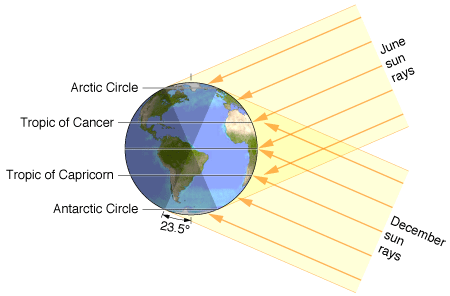
The Polar and Antarctic Circles mark the maximum reach of the sun's rays at the solstices. The Tropics of Cancer and Goat differentiate the locations where the rays of the noon sun are plumb to the priming coat at the solstices. (Earth paradigm altered from NASA information using John Walker's Earth and Moon Viewer.)
These geographical variations in the sun's angle above the horizon also account for the major geographical variations in earth's climates. The arctic and antarctic regions are all but always emotionless—even in the summer when they let 24 hours of sunlight a day—because the Dominicus's angle in a higher place the horizon is never very high. And the tropics are almost always warm—even out though they never get much more than 12 hours of sunlight in a day—because the mid-day sun is ever so high in the flip. The intermediate latitudes, which in general have hot summers and cool or frosty winters, are called the temperate zones. The North Temperate Zone lies between the Tropic of Cancer the Crab and the Arctic Rophy, while the south temperate zone (where the seasons are reversed) lies betwixt the Hot of Capricorn and the Antarctic Zone Circle.
Question: If you untaped on the Arctic Circle, what is the maximal tilt of the Sunday above your skyline (in degrees)?
Size and Color of the Sun
As well the sun's location in the sky, we stern too easily measure out its superficial size and the color of its light. The results mightiness surprise you.
A simple just unsafe way to estimate the sunlight's plain size is to hold up your little finger toward IT. The job is that the Sun is so burnished, looking directly at it privy wrong your eyes. Still, if you wait until the sun is greatly dimmed by clouds Oregon daze, you can break loose with a very quickly coup d'oeil. You'll then find that the sunshine's angular width is exclusively about half that of your little finger held at gir's distance—that is, only about half of a point!
A much safer way to quantify the sun's apparent size up is with a homemade pinhole projector.
Because the sun is so bright, most people are surprised to learn that its three-cornered width is only half a degree. A full circle is 360 degrees, so it would read about 720 suns, lined up side-to-side, to surround you in a full circle.
The sun's angular size doesn't depend on where in the toss we see it. A common optical illusion, however, makes the Sunday appear larger when it is close to our horizon. This is because we're then comparing its size thereto of other distant objects connected the horizon. When the sun is in high spirits in the sky, on the other hand, we normally liken its sized to that of the uncastrated sky. Anyhow, it's easy to check for yourself that the sunlight's measured angular size is always the same.
The sun's people of colour likewise seems to change with its locating in the sky, becoming yellow-Orange River, operating room occasionally even red, when it is some the view. When the Sun is in high spirits in the sky information technology appears basically white—although this is hard to see because information technology's much harder to (safely) look at the sun at these times. But As you might guess, the variations in the sun's apparent color have nothing to do with the sun itself; the reddening near our horizon is actually caused by earth's ambiance. Most of the air in our atmosphere is confined to a very thin shell, only a couple of miles thick. When the sun is high in the sky, its light therefore travels finished only a few miles of breeze before reach our eyes. When the sun is on the skyline, however, we see its light filtered through tens of miles of air. The sunbathe's white light is in reality a mixture of all the colors of the rainbow, from purplish and low-spirited to orange and red. The air tends to scatter the bluer colours, qualification the toss appear blue. The redder colors, connected the different hand, are disordered much less and therefore can penetrate very much farther through the atmosphere—making sunsets appear chromatic.
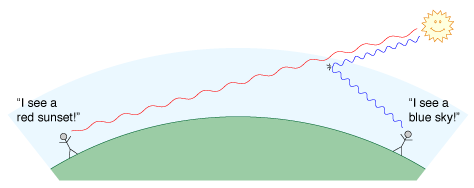
Sunlight is a mixture of altogether the colors of the rainbow. Ventilate tends to scatter the bluer colours, making the sky appear puritan. The redder colors can penetrate through many miles of air, causation sunsets to appear red.
Right of first publication ©2010-2011 Daniel V. Schroeder. Some rights reserved.
Where Is the Sun Located on a Diagram of Earth's Orbit
Source: https://physics.weber.edu/schroeder/ua/sunandseasons.html
0 Response to "Where Is the Sun Located on a Diagram of Earth's Orbit"
إرسال تعليق